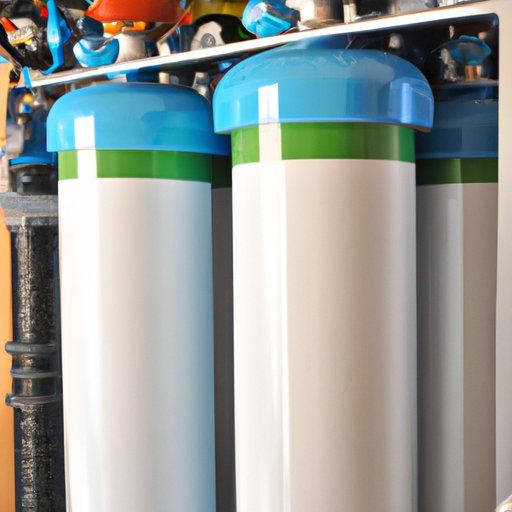I. Introduction
When it comes to water, not all types are created equal. Hard water, which contains large amounts of minerals like calcium and magnesium, can cause problems with plumbing, soap and detergent, and even your own skin and hair. But you don’t have to put up with it forever – in this guide, we’ll cover everything you need to know about water softeners, from how they work to how to choose the right one for your home.
II. An Overview of Water Softeners: How They Work and Why You Need One
So, let’s start with the basics: how does a water softener work? In essence, it’s a device that removes the minerals from your water through a process called ion exchange. The hard water flows through a tank filled with small polystyrene beads, which are coated with sodium ions. The resin beads attract the mineral ions and swap them for sodium ions, which don’t cause the same problems as hard minerals. The result? Soft water that’s free of excess minerals.
And why do you need one? Well, hard water can cause a host of issues, from mineral buildup in appliances and pipes to soap that doesn’t lather properly. Using a water softener can help prolong the life of your plumbing, improve the efficiency of your appliances, and even benefit your health and appearance.
III. Hard Water vs. Soft Water: The Importance of Softening Your Water
Let’s look at some of the specific problems that hard water can cause. First, it can lead to limescale buildup in plumbing and appliances, which can cause them to break down faster and require more frequent repairs. Second, hard water can prevent soap and detergent from dissolving properly, leading to skin irritation, dingy clothes, and a residue buildup on dishes and surfaces.
On the other hand, soft water has a host of benefits. For one, it can keep your skin and hair healthier and more hydrated, since it doesn’t strip away natural oils like hard water can. Soft water also requires less soap and detergent to achieve the same results, which can translate to cost savings over time.
IV. A Beginner’s Guide to Water Softeners: Everything You Need to Know
If you’re in the market for a water softener, you’ll likely be confronted with a range of options and variables to consider. Here are a few things to keep in mind:
– Types of water softeners available in the market: Some options include salt-based, salt-free, and magnetic water softeners.
– How to choose the best water softener for your needs: Factors to consider include water hardness levels, household size, and budget.
– Maintenance and upkeep of water softeners: Common tasks include checking salt levels, cleaning the resin tank, and getting regular professional tune-ups.
V. From Magnesium to Calcium: The Minerals in Hard Water and How a Water Softener Can Help
As we mentioned earlier, hard water is characterized by high levels of minerals like calcium, magnesium, and iron. Over time, these minerals can form deposits and buildup in your pipes and appliances, stopping them from functioning properly. With a water softener, these minerals are removed through the ion exchange process, leaving you with cleaner, healthier water.
VI. The Benefits of a Water Softener: Healthier Skin, Cleaner Clothes, and More
So, what exactly are the benefits of using a water softener?
– Healthier skin and hair: Soft water doesn’t strip away natural oils like hard water can, leaving you with smoother, more hydrated skin and hair.
– Cleaner dishes and laundry: With fewer mineral deposits, your dishes, clothes, and linens can come out looking and feeling cleaner.
– Longer-lasting appliances: Without the corrosive effects of hard water, your plumbing and appliances can function properly for longer.
– Cost savings: Using less soap and detergent can add up to significant savings over time.
VII. How to Install a Water Softener: A Step-by-Step Guide for Homeowners
If you’re handy and want to install your water softener yourself, here’s a general guide to the steps involved:
– Preparing for installation: Shut off water to your home, find a suitable location for the water softener, and gather materials and tools.
– The installation process and tools required: This will vary depending on the type of water softener you choose, but generally involves installing a bypass valve and connecting the water softener to your existing plumbing.
– Setting up and testing the water softener: After installation, you’ll need to add salt to the brine tank and flush the system to get it operational. From there, you can test the water to ensure it’s coming out soft.
VIII. Conclusion
So, there you have it – everything you need to know about water softeners. These handy devices can help you solve a host of hard water problems, from crusty dishes to broken-down appliances. Whether you’re looking for a DIY installation or want to hire a professional, there’s a water softener out there that’s right for your needs.
